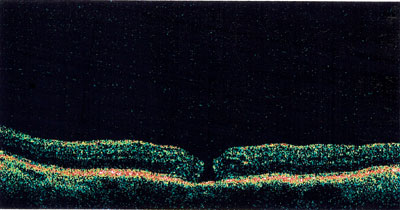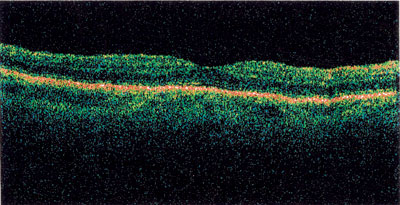Inversion prism lenses help ease patients’ recovery from retinal surgery
A new prism spectacle lens developed for the postsurgical retina patient allows these individuals to continue daily living activities while recovering from the procedure.
Surgery for macular hole repair, which is often combined with epiretinal membrane removal and vitrectomy, requires patients to maintain a head-down position for extended periods of time. To increase patient comfort and function, I used a right angle prism spectacle applied in an inverse position.
Mirror prism lenses
The application of mirror prism lenses in patients who are required to lie flat on their back with eyes and head directed toward the ceiling is well known. To correct the vision in a head down position, I reversed the prism lenses, placing them upside down on the nose.
 Mirror prism lenses are reversed and placed upside down on the nose, facilitating vision while the postsurgical patient remains in the head-down position. Images: Fair RG |
Worn this way, the lenses permit the patient to see TV, a laptop computer and reading materials while looking in the head down position toward the floor. An elastic cord attached to the temples is used to hold the frame comfortably in place.
Case report
A 61-year-old male experienced sudden visual loss as a result of a spontaneous hole in the macula. I examined him and obtained a retinal consult. The presence of a cataract precluded the possibility of retinal surgery. The cataract was removed and an IOL was implanted.
A week later, the epiretinal membrane was surgically removed and the hole repaired. Postsurgically, the patient was placed in a face-down position and required to stay prone for 21 days. He experienced much frustration trying to see and use objects placed on the floor.
 |
 |
OCT images show the macular hole (top)
and the recovered retina (bottom).
Images: Fair RG |
I designed the application of reverse prism lenses in response to this patient’s intense frustration. The remainder of his recovery became much more tolerable while using the prism lenses. The retinal surgeon was pleased with the results and has recommended the method to other patients. I have had the opportunity to use the same method with three other patients who also enjoyed the visual benefits from the prisms.
The use of inverted prism spectacles permits patients to view TV or see people seated directly across from them while looking toward the floor. They enhance patient comfort and tolerance of the head-down position while contributing to a successful recovery. Patients can continue to use a laptop computer, read books and talk with people.
The frequency with which surgery is now being used for retinal repair and requiring a head-down positioning calls for such innovative methods to benefit these patients. I would encourage colleagues and retinal surgeons to consider using this technique.
For more information:
- Ron G. Fair, OD, FAAO, can be reached at 1001 East Bridge Street, Suite A, Brighton, CO 80601-1639; (303) 659-3036; fax: (303) 659-0053; e-mail: fairone@comcast.net.
